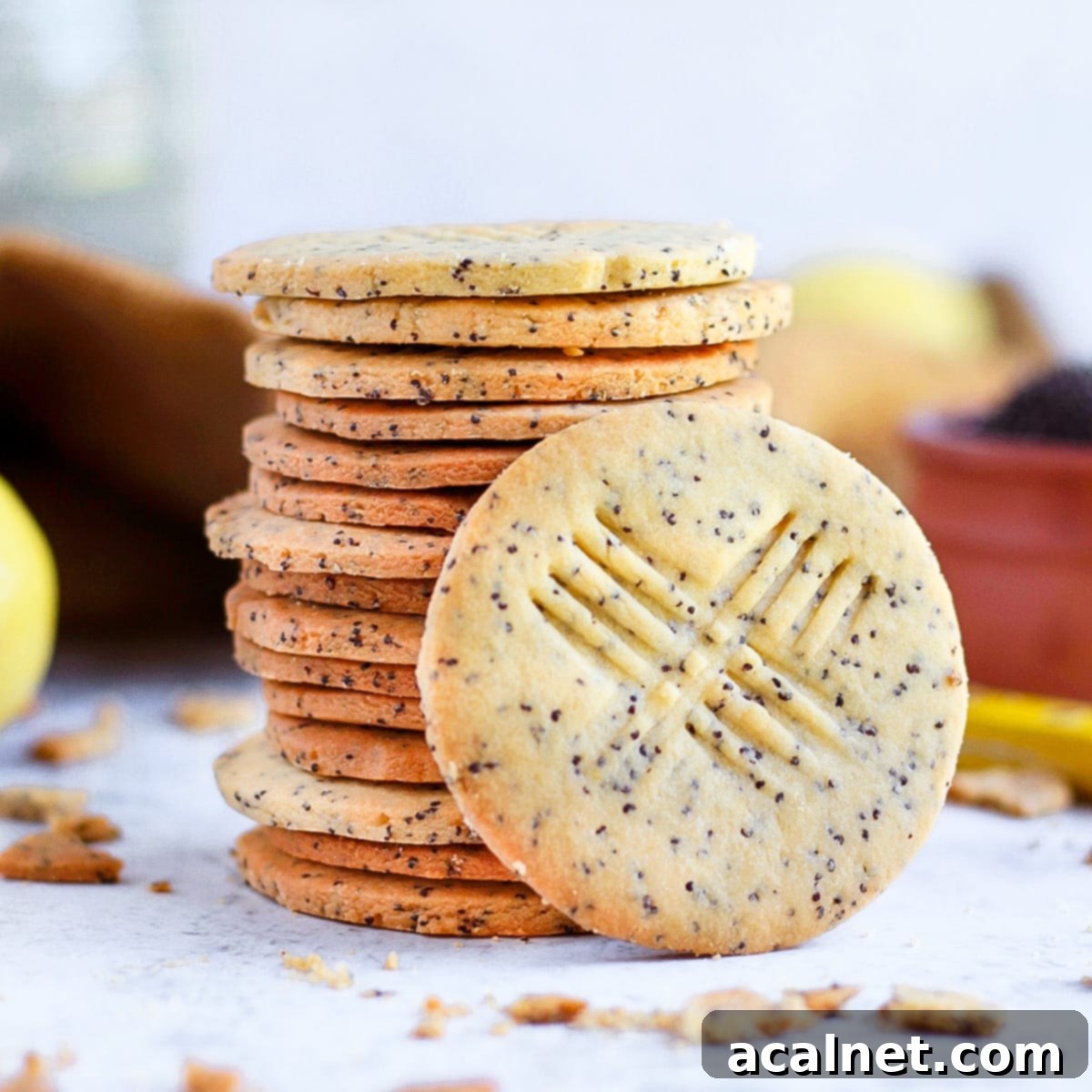Irresistibly Easy Lemon Poppy Seed Shortbread Cookies: A Zesty, Buttery Delight
Experience the perfect blend of textures and flavors with these Lemon Poppy Seed Shortbread Cookies. Soft, wonderfully crumbly, bursting with tangy lemon, and offering a delightful crunch from poppy seeds, these cookies are incredibly easy to bake. This French-style shortbread recipe is your go-to for a delicious snack, whether enjoyed with a warm cup of tea or coffee, or as a sweet treat any time of day. Prepare for a truly melt-in-your-mouth experience that will quickly become a favorite in your kitchen.
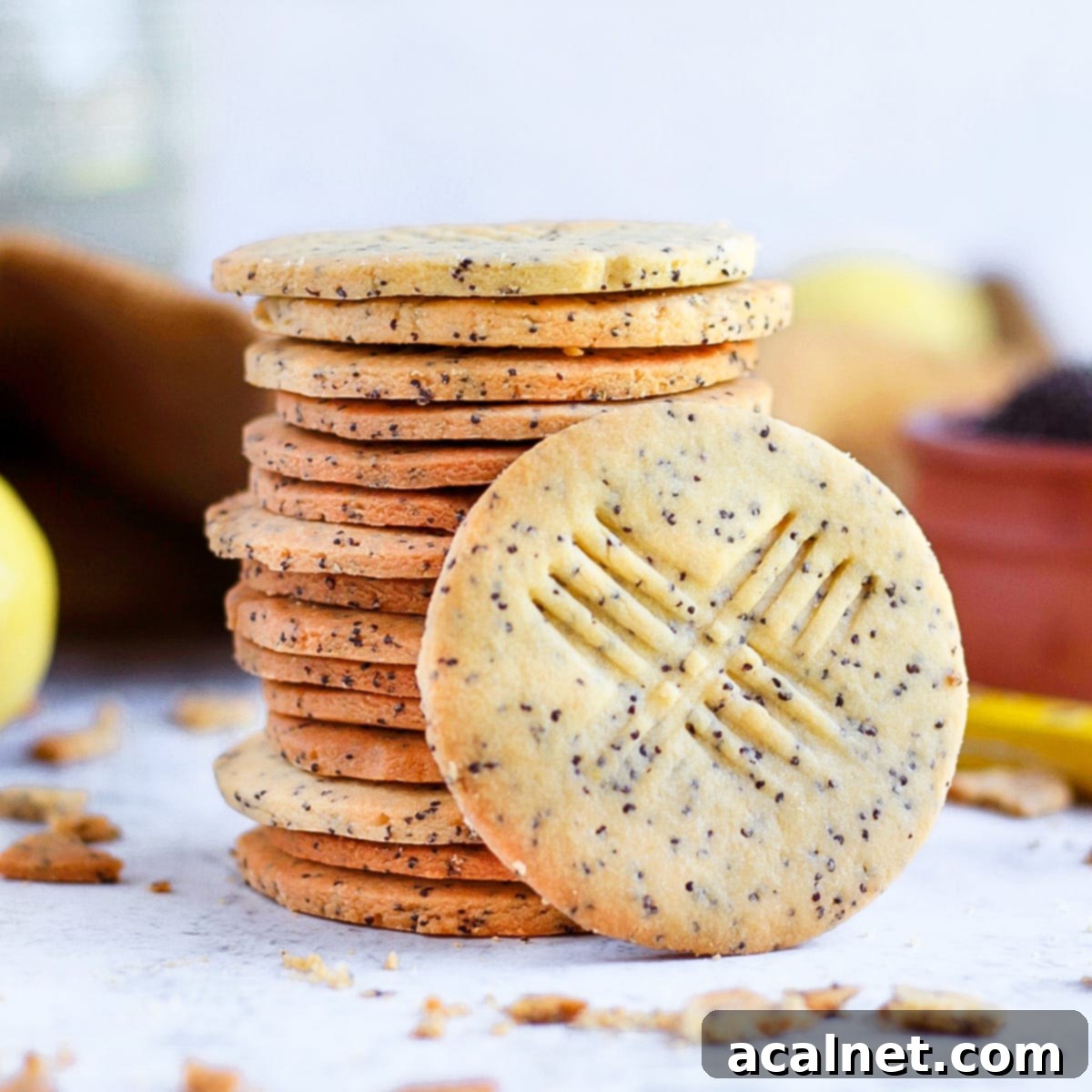
Why You’ll Adore These Lemon Poppy Seed Shortbread Cookies
These Lemon Poppy Seed Shortbread Cookies truly stand out as a delightful sweet treat, perfect for your afternoon tea — or, if you’re like me, your afternoon coffee. What makes them so special is their exquisite balance of textures and flavors. You’ll immediately notice their satisfyingly crumbly yet distinctly crunchy texture, largely thanks to the generous inclusion of poppy seeds. This is beautifully complemented by a vibrant mix of sweetness and tanginess, creating a truly harmonious flavor profile.
Unlike many traditional shortbread recipes that primarily focus on butter, our version is inspired by the classic French “Sablé Breton”. This means we incorporate egg yolks, which lend an incredible richness and a slightly more robust, yet still melt-in-your-mouth, quality to the cookies. This subtle difference elevates them beyond a simple British-style shortbread, giving them a unique depth of flavor and a beautiful golden hue.
These lemon shortbread biscuits are incredibly versatile. Enjoy them plain for a quick, buttery bite, or elevate them into an indulgent treat by topping them with a luxurious Lemon Curd. You can even use them to create delightful sandwich cookies, much like our popular Lemon Curd Cookies. They’re not just for everyday snacking; their festive appeal makes them ideal for the Holiday Season, Christmas cookie exchanges, or as thoughtful homemade gifts.
Note: This particular shortbread recipe is inspired by the traditional French Sablé Breton, distinguished from British shortbread primarily by the inclusion of egg yolks, which impart a richer texture and deeper flavor.
More Delicious Shortbread Cookie Recipes:
- Strawberry Shortbread Cookies
- Almond Shortbread Cookies
- Chocolate Hazelnut Shortbread Cookies
- Pistachio Shortbread Cookies
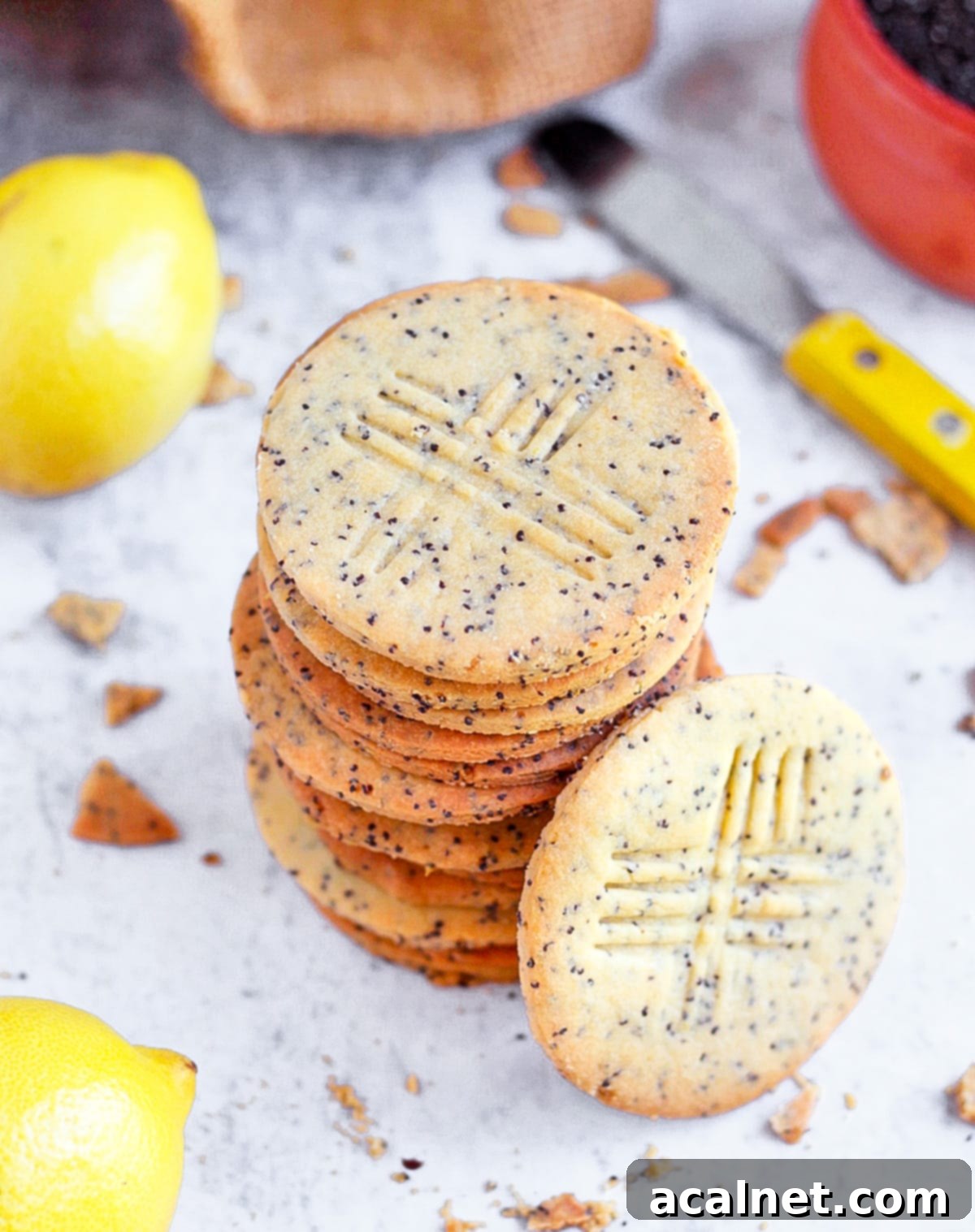
Essential Ingredients for Perfect Lemon Poppy Seed Shortbread
Crafting these delectable Lemon Poppy Seed Cookies starts with a simple yet powerful list of ingredients. This recipe builds upon the foundation of my cherished French Sablés Bretons Cookies, thoughtfully incorporating zesty Lemon Zest, bright Lemon Juice, and crunchy Poppy Seeds to create a uniquely delightful flavor profile. Achieving the perfect texture and taste relies on understanding the role of each component, so let’s delve into what you’ll need.
You will need (scroll down to recipe card for all exact quantities):
- Soft Unsalted Butter: This is the star of any shortbread! Using unsalted butter allows you to control the salt content precisely. If you’re aiming for a flavor profile closer to the traditional French Sablés Bretons, which often feature a hint of saltiness to balance the sweetness, you can certainly opt for good quality salted butter and then omit the additional salt in the recipe. Ensure your butter is at room temperature for optimal creaming.
- Icing Sugar (or Powdered Sugar): More than just sweetening, icing sugar plays a crucial role in the texture of these cookies. The finely milled sugar, often containing a small amount of cornstarch, helps create a wonderfully tender yet snappy crumb that is characteristic of premium shortbread.
- Egg Yolks: A hallmark of French shortbread, the egg yolks are vital. They contribute significant richness, a beautiful golden color, and act as a binder, giving these cookies their distinct melt-in-your-mouth quality and a slightly firmer structure compared to egg-free shortbread.
- Lemon: We utilize both the Zest and the Juice of fresh lemons to infuse maximum citrus flavor. The zest provides aromatic oils for a vibrant, bright flavor, while the juice adds that essential tangy punch. For a less intense tang, you can reduce or omit the juice and rely primarily on the zest for its fragrant notes. Using organic lemons is recommended, especially when zesting, to avoid pesticides.
- Plain Flour (All-Purpose Flour): This forms the structural backbone of your cookies. Simple and straightforward, it provides the necessary body without overpowering the delicate flavors.
- Baking Powder: Just a touch of baking powder is added to give these cookies a slightly lighter, more airy texture without making them cakey. It contributes to that perfect crumbly-yet-tender bite.
- Salt: A pinch of salt is crucial for balancing the sweetness and enhancing all the other flavors, particularly the lemon. If you opt for salted butter, you can reduce or completely omit this extra pinch.
- Poppy Seeds: These tiny seeds are not only visually appealing but also provide that signature crunch and a subtle nutty flavor that beautifully complements the lemon. You can adjust the quantity to your liking, using more for an extra crunchy biscuit or less for a softer texture.
Both the Zest and Juice of the lemons are essential to impart a truly vibrant citrus pop to these cookies! However, if you prefer a milder lemon flavor with less tang, you can certainly choose to include only the zest and omit the juice.
More Delightful Poppy Seed Recipes:
- Lemon Poppy Seed Muffins
- Lemon and Poppy Seed Loaf Cake
- Orange Poppy Seed Muffins
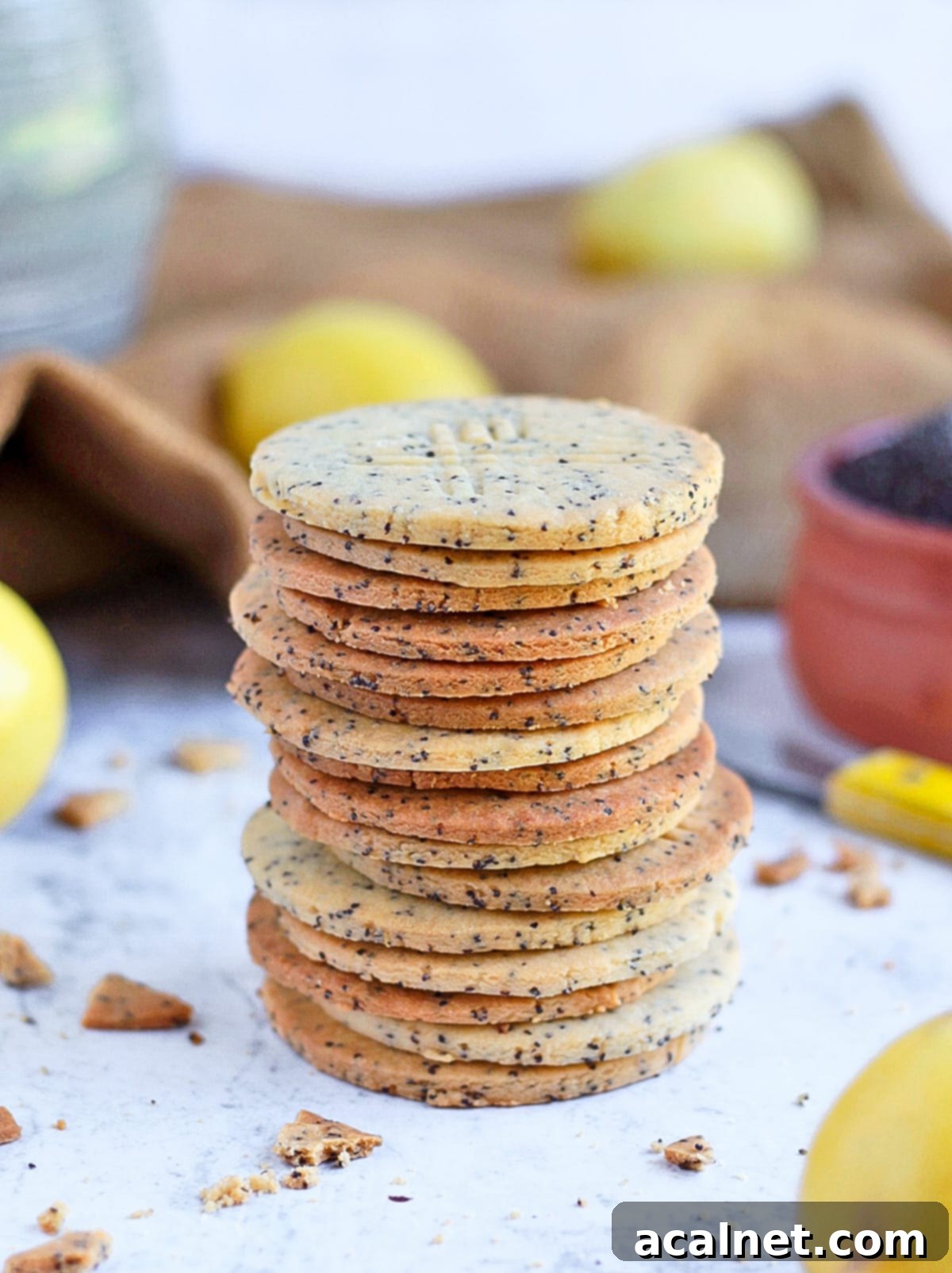
How to Make Zesty Lemon Poppy Seed Cookies
Creating these delightful cut-out lemon shortbread cookies is a straightforward process, closely mirroring the method for most classic shortbreads, with the wonderful addition of fresh lemon and poppy seeds. The key to their tender, buttery texture lies in three simple yet crucial steps:
- First, we meticulously cream the butter and sugar until light and fluffy.
- Next, we gently incorporate the rich egg yolks and the vibrant liquid lemon components.
- Finally, we carefully fold in the dry ingredients and poppy seeds to form our perfect dough.
To make these irresistible Lemon Poppy Seed Shortbread Cookies:
- Cream Butter and Sugar: Begin by placing the truly soft, room temperature unsalted butter and the icing sugar into the bowl of your stand mixer. Using the paddle attachment, cream these two ingredients together on medium speed for at least 5 minutes. This extended creaming time is essential; it incorporates air into the mixture, resulting in a pale, fluffy, and significantly increased volume, which is key to light and airy shortbread.
- Add Wet Ingredients: Introduce the egg yolks, one by one, ensuring each is fully incorporated before adding the next. This prevents the mixture from splitting and maintains a smooth emulsion. Follow with the fresh lemon juice and fragrant lemon zest, beating just until they are evenly combined.
- Incorporate Dry Ingredients and Poppy Seeds: Sift the plain flour, baking powder, and salt directly into the wet mixture. Mix on low speed until the dough just begins to come together. Be careful not to overmix, as this can develop the gluten in the flour, leading to tough cookies. Finally, stir in the poppy seeds until they are evenly distributed throughout the dough.
Shaping Your Perfect Shortbread Cookies
Once your dough is ready, you have a couple of fantastic options for shaping your Lemon Poppy Seed Shortbread Cookies: you can either roll the dough into a log and slice it, or, as we’re doing here, roll it into a thick sheet and use your favorite cookie cutters.
- Prepare and Chill the Dough: Transfer the freshly mixed dough onto a sheet of baking paper. Gently gather it into a cohesive ball, then flatten it slightly. Cover the dough with a second sheet of baking paper. Using a rolling pin, roll the dough evenly to your desired thickness (I typically go for about 2-3 mm or 0.1 inch for a crispier cookie). Once rolled, slide the dough, still between the baking paper sheets, onto a flat tray and place it in the fridge. Allow it to chill for a crucial 10 to 15 minutes. This chilling period firms up the butter, making the dough much easier to handle and preventing the cookies from spreading too much during baking.
- Preheat Oven & Cut Cookies: While the dough chills, preheat your oven to 160°C (325°F). Once the dough is adequately chilled, remove the top sheet of baking paper. Use your chosen cookie cutter to carefully cut out the cookie shapes. Transfer these delicate cut-out cookies to a baking tray lined with fresh baking paper or a silicone baking mat.
- Optional Criss-Cross Pattern: For a classic shortbread look, gently press the back of a fork onto each cookie to create an appealing criss-cross pattern. This also helps to vent the cookies slightly.
- Bake to Golden Perfection: Bake your lemon poppy seed shortbread cookies for 10 to 15 minutes. The precise baking time will vary depending on the thickness of your cookies and the nuances of your oven. Keep a close eye on them; they are ready when their edges just begin to turn a beautiful golden brown. Avoid over-baking to maintain their tender crumb.
- Re-rolling Scraps: Gather any leftover dough scraps, gently re-roll them between two sheets of baking paper, and chill again briefly before cutting out additional cookies. This ensures consistent quality for all your delicious batches.
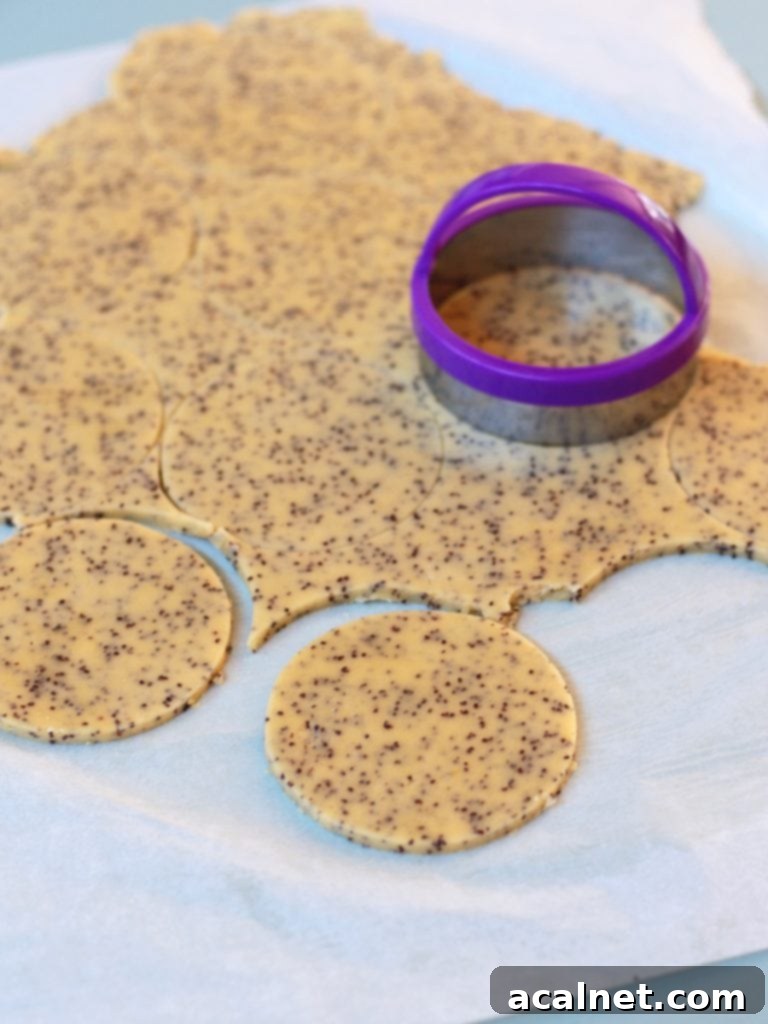
Expert Tips for Unforgettable Lemon Poppy Seed Shortbread Biscuits
To ensure your Lemon Poppy Seed Shortbread Cookies are nothing short of perfect, follow these expert tips:
- Use quality butter. Shortbread is primarily about butter, so the quality truly shines through. Opt for a good European-style butter with a higher fat content if possible, as it will yield a richer flavor and superior crumbly texture. This single ingredient makes the biggest difference!
- Make sure your Butter is at ideal room temperature. This is absolutely critical. If your butter is too cold, it won’t emulsify properly with the sugar, leading to a lumpy mixture and a denser cookie. The perfect consistency is soft enough to easily spread, but not melted or greasy. Cut your butter into small cubes and let it sit at room temperature for about an hour; it should yield easily when gently pressed with a finger.
- Cream the Butter and Icing Sugar for at least 5 minutes. This step is non-negotiable for light shortbread! The goal is to incorporate a significant amount of air, making the mixture visibly pale and fluffy. This aeration contributes directly to the cookies’ delicate, tender, and “melt-in-your-mouth” quality.
- The Egg Yolks should also be at room temperature. Cold egg yolks can cause the beautifully creamed butter and sugar mixture to seize or split, affecting the dough’s texture. Bring them out with the butter to ensure they are at the same temperature.
- Use Organic Lemons whenever possible. Since we’re using a generous amount of lemon zest, which is where many pesticides reside on non-organic fruits, choosing organic ensures a cleaner, purer lemon flavor without unwanted chemicals. Plus, organic lemons often have a more intense aroma!
- Roll the dough immediately after mixing, between two sheets of baking paper. The dough is softer and more pliable when freshly made, making it easier to roll without tearing. Rolling between baking paper also prevents sticking, reduces the need for extra flour (which can dry out the dough), and makes transferring the rolled dough to the fridge a breeze.
- Utilize your preferred Cookie Cutter to personalize your shortbread. While a simple round cutter works beautifully, don’t hesitate to use fluted, scalloped, or even seasonal shapes to make them extra special. Just ensure your cutter is sharp for clean edges.
- Adjust the baking time based on cookie size and thickness. Thinner cookies (like my preferred 2-3 mm or 0.1 inch) will bake faster, typically around 10 minutes. For thicker shortbread, you’ll need a few extra minutes. The key indicator for doneness is when the edges just begin to turn a light golden brown. Keep a close eye to prevent over-baking, which can lead to a dry, less tender cookie.
- Don’t overwork the dough once the flour is added. Overmixing develops gluten, which can make your shortbread tough instead of crumbly. Mix just until the ingredients are combined and no streaks of flour remain.
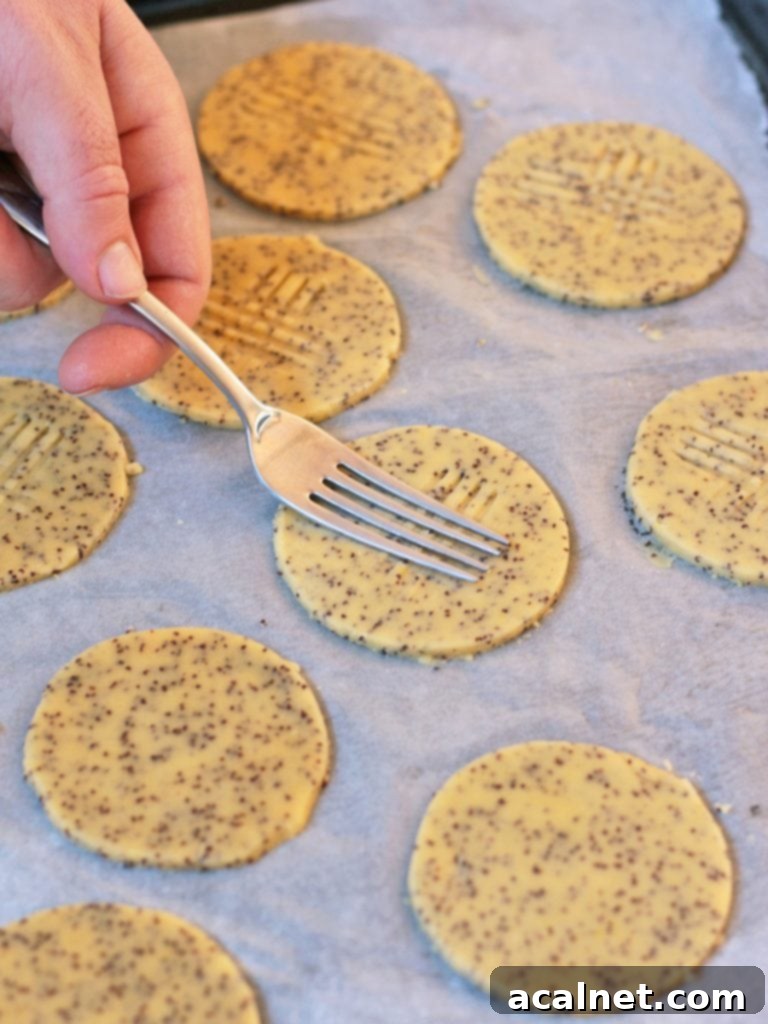
Lemon Poppy Seed Shortbread FAQs
To maintain their delightful crispness and flavor, store your baked lemon poppy seed shortbread cookies in an air-tight container at room temperature. Placed in a cool, dry pantry, they will remain fresh and delicious for 3 to 4 days. If you wish to extend their freshness, especially in humid climates, you might consider refrigerating them, though this can sometimes alter their texture slightly.
Absolutely! Most shortbread cookies, including these lemon poppy seed delights, freeze exceptionally well. While you can freeze baked cookies, I highly recommend freezing them unbaked. Freezing the dough and baking fresh later results in a superior, “just-baked” taste and texture that’s hard to beat.
Freezing unbaked cookie dough is a fantastic strategy for having fresh cookies on demand. Here’s how to do it effectively:
– First, prepare and shape your cookies exactly as advised in the recipe. Place the individual cookies (uncooked) on a flat baking tray, ensuring they are not touching. Cover the tray loosely with plastic wrap and place it in the freezer for a couple of hours, or until the cookies are completely solid.
– Once frozen solid, transfer the individual cookies into a freezer-friendly air-tight container or a heavy-duty freezer bag. Layer them with sheets of baking paper between each layer to prevent them from sticking together. This way, you can easily grab just a few cookies when a craving strikes!
– When you’re ready to bake, there’s no need to thaw! Simply arrange the frozen shortbread cookies on a baking tray lined with parchment paper and bake them directly from frozen. You will likely need to add an extra 2 to 5 minutes to the baking time specified in the recipe to account for them being frozen. Keep an eye on the edges for that tell-tale golden brown color.
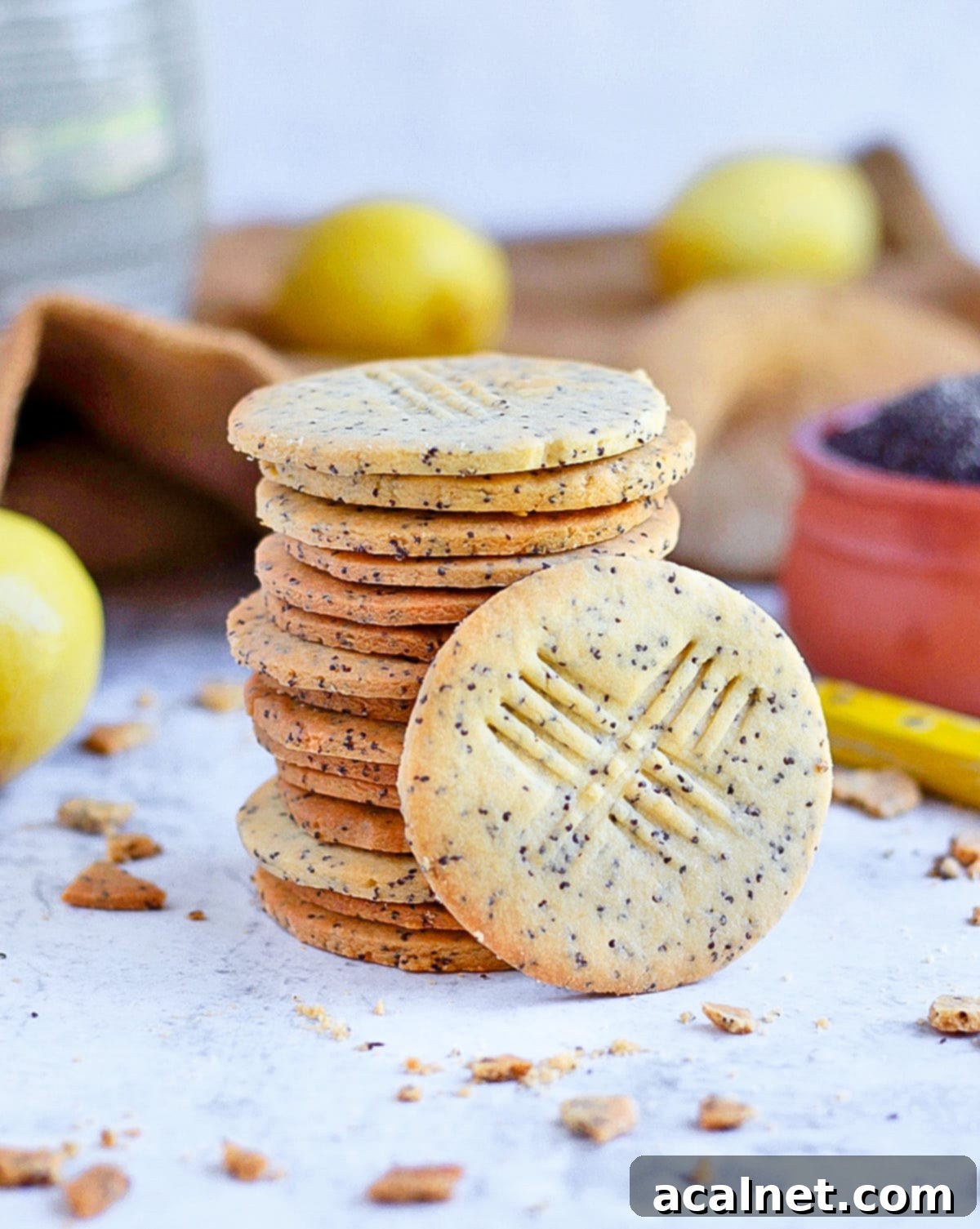
More Perfect Afternoon Tea Treats to Enjoy
If you love these Lemon Poppy Seed Shortbread Cookies, you’re sure to enjoy these other delightful treats, perfect for any afternoon tea spread or sweet craving:
- Lemon Curd Tartlets
- Almond Flour Peanut Butter Cookies
- Mini Lemon Meringue Pies
- Chocolate Chip Scones
- Chocolate Peanut Butter Balls
- Mini Lemon Cheesecakes
- Oat Flour Chocolate Chip Cookies
- Strawberry Cheesecake Cookies
Made this recipe?
Let us know if you liked it by leaving a comment below, and tag us on Instagram @a.baking.journey with a photo of your creation!
Recipe Card: Lemon Poppy Seed Shortbread Cookies

Lemon Poppy Seed Shortbread Cookies
Print Recipe
Ingredients
- 100 gr (7 tablespoons) Unsalted Butter, soft
- 30 gr (1/4 cup) Icing Sugar, or Powdered Sugar
- 3 Egg Yolks, at room temperature
- 1 Lemon Zest, (zest of 1 small lemon)
- 15 ml (1 tablespoon) Lemon Juice
- 175 gr (1 cup + 2 tablespoons) Plain Flour
- 1/2 teasp. Baking Powder
- 1 pinch Salt
- 20 gr (2 tablespoons) Poppy Seed
Instructions
- Place the soft Butter (1) and Icing Sugar in the bowl of your mixer, and cream them together using with the paddle/flat beater attachment for at least 5 minutes on medium speed. It needs to look pale, fluffy and have increased in volume.
- Add the Egg Yolks one at the time, beaten well between each addition. (2)
- Pour in the Lemon Juice and Lemon Zest and mix for a few seconds to combine.
- Sift in the Flour, Baking Powder and Salt. Mix until the dough starts to come together, stopping to scrap the edges of the bowl if required, then add the Poppy Seeds.
- Transfer the dough over a sheet of baking paper, bring it together into a ball and gently press on it to flatten it. Cover with a second sheet of baking paper and roll into the desired thickeness (3) with a rolling pin.
- Place in the fridge to rest for 10 to 15 minutes (4).
- Preheat the oven on 160’C/325’F.
- Remove the top sheet of baking paper and use a Cookie Cutter to shape the shortbread (5). Use an offset spatula to transfer the cookies on a flat baking tray.
- Optional: use a fork to create a criss-cross strips pattern
- Bake for 10 to 15 minutes, depending on the thickness of the cookies, or until the edges start to turn golden brown.
Would you like to save this recipe?
We’ll email this post to you, so you can come back to it later!
Notes
- Make sure the butter is really soft and at room temperature, or it will be hard to mix it in with the Sugar. A tip to get the right consistency of butter is to cut it into small cubes and leave it at room temperature for about an hour (more or less depending on the temperature of the room). To check if it is soft enough, gently press on it; it should easily spread without too much resistance. Be careful if trying to use the microwave to soften it more quickly – you do not want the butter to melt at all.
- If the batter seems to split after you add the yolks, it could be because the butter wasn’t soft enough/too cold, because the yolks were not at room temperature or because you did not beat the butter and sugar for long enough. Don’t worry though, the batter will still come together once you add the flour.
- I like my shortbread really thin, so I rolled the dough to about 2/3 mm (0.1 inch). You can absolutely roll them thicker if preferred.
- It is important to chill the cookies before shaping them and moving them as they will be very soft before refrigeration. You need to butter to have harden again to easily transfer the cookies over a baking sheet.
- Re-roll any leftover dough/scraps between the two sheets of baking paper and refrigerate again before cutting out more cookies.
Nutrition (per serving)
